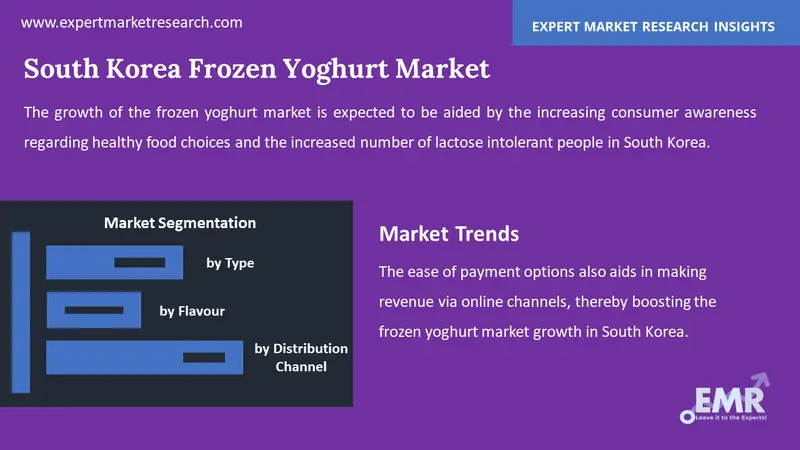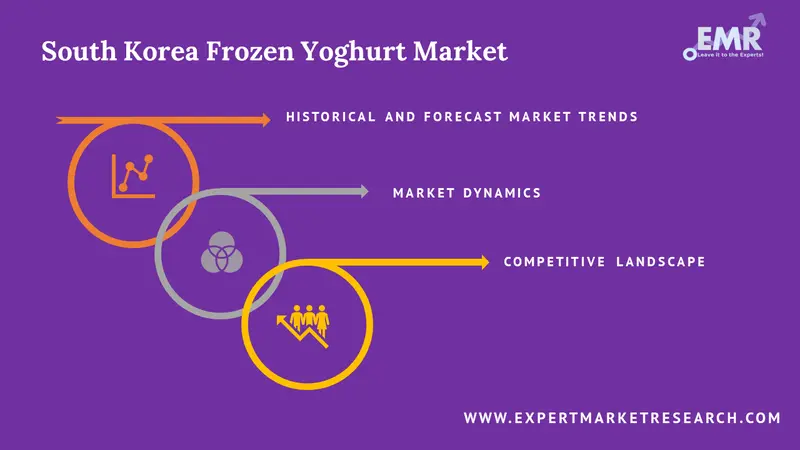
Consumer Insights
Uncover trends and behaviors shaping consumer choices today
Procurement Insights
Optimize your sourcing strategy with key market data
Industry Stats
Stay ahead with the latest trends and market analysis.
The South Korea frozen yoghurt industry is expected to grow at a CAGR of 3.50% between 2026 and 2035. Customers seeking a healthy alternative to frozen desserts are anticipated to have a wide range of alternatives thanks to the rising popularity of low-fat frozen yoghurt and the launch of healthy lactose-free as well as non-dairy versions in a number of flavours.
Base Year
Historical Period
Forecast Period
Compound Annual Growth Rate
3.5%
2026-2035
*this image is indicative*
Furthermore, customers are choosing quick frozen dessert-based snacks, which is also bolstering the frozen yoghurt market in South Korea.
Yoghurt taste and an ice cream-like texture characterise frozen yoghurt. Typically, it is made by adding natural yoghurt to an ice cream mixture and freezing it. There are several types of frozen yoghurt, including firm, soft, and mousse-frozen variants. These are widely eaten as desserts in South Korea.
One of the most well-liked desserts is frozen yoghurt. Since yoghurt is made from cultured milk, which sometimes leaves behind a sour taste, frozen yoghurt also contains added sugars and flavours to balance out the sourness. In addition, frozen yoghurt includes probiotics because it is made of yoghurt. Frozen yoghurt generally has less calories and less fat than ice cream, however, the nutritional value varies by brand. It is also said to contain more protein than ice cream, which makes frozen yoghurt a superior substitute for ice cream. This factor attracts health-conscious consumers who don't want to compromise with taste while focusing on their health.
It is anticipated that the use of natural flavours and the development of vegan frozen yoghurt in a variety of flavours will present opportunities for market participants. Additionally, it is projected that the industry will grow in the next few years due to the popularity of frozen yoghurt as a refreshing dessert throughout the summer. Consumers are now much more inclined toward sustainable food products, and there's an increased demand for plant-based vegan food items, which also aids the development of the market as manufacturers now launch various flavour variants of foryo in the market. Moreover, due to urbanisation, improved living standards, and rising disposable income, people now more willingly spend on premium frozen yoghurt. Low-sugar desserts are popular among both the elderly and younger generations, which bolsters the growth of the yoghurt market in South Korea.
The EMR’s report titled “South Korea Frozen Yoghurt Market Report and Forecast 2026-2035" offers a detailed analysis of the market based on the following segments:
Market Breakup by Type
Market Breakup by Flavour
Market Breakup by Distribution Channel

Read more about this report - REQUEST FREE SAMPLE COPY IN PDF
The growth of the frozen yoghurt market is expected to be aided by the increasing consumer awareness regarding healthy food choices and the increased number of lactose intolerant people in South Korea. This leads to increased consumption of lactose-free dairy products, and with an increase in disposable income, more people now choose non-dairy variants as well.
With the increasing demand for frozen yoghurt, manufacturers are launching various flavours to cater to the desires of all age groups. Although there are many different frozen yoghurt alternatives, they all offer certain health benefits, including lower calories, less fat, and more good bacteria. Frozen yoghurt contains helpful probiotic bacteria, which is beneficial for the digestive system. There are other nutrients, including protein, vitamin D, and calcium. This factor aids in attracting health-conscious consumers in the country.
The distribution of frozen yoghurt is growing gradually due to various offers and coupons provided when purchased on online platforms. The market is quite competitive and is continuously developing due to the continuous research and development work of companies. Offline distribution chains are well established in South Korea therefore supermarkets/hyperstores and convenience stores have a strong presence. The ease of payment options also aids in making revenue via online channels, thereby boosting the frozen yoghurt market growth in South Korea.

Read more about this report - REQUEST FREE SAMPLE COPY IN PDF
The comprehensive EMR report provides an in-depth assessment of the market based on the Porter's five forces model along with giving a SWOT analysis. The report gives a detailed analysis of the following key players in the South Korea frozen yoghurt market, covering their competitive landscape and latest developments like mergers, acquisitions, investments and expansion plans.
Namyang Co., Ltd.- Yoghurt, milk, ice cream, infant formula, cheese, and other dairy products are all produced by Namyang Dairy Products Co., Ltd. The company mostly sells its goods domestically. The company was incorporated in 1964 with headquarters in Seoul South Korea.
Binggrae Co., Ltd.- A South Korean business called Binggrae Co., Ltd. produces and sells products for the processing of dairy. Milk, milk products, and snacks are all produced and sold by Binggrae. Through constant challenges, research, and innovation since its founding in 1967, Binggrae has helped the Republic of Korea's food sector progress.
*Please note that this is only a partial list; the complete list of key players is available in the full report. Additionally, the list of key players can be customized to better suit your needs.*




*While we strive to always give you current and accurate information, the numbers depicted on the website are indicative and may differ from the actual numbers in the main report. At Expert Market Research, we aim to bring you the latest insights and trends in the market. Using our analyses and forecasts, stakeholders can understand the market dynamics, navigate challenges, and capitalize on opportunities to make data-driven strategic decisions.*
Get in touch with us for a customized solution tailored to your unique requirements and save upto 35%!
The market is projected to grow at a CAGR of 3.50% between 2026 and 2035.
Urbanization, improved living standards, R&D work, rising disposable income, premiumization of frozen yoghurt, and the availability of lactose-free variants are the major drivers of the industry.
Health benefits and growing demand for sustainable frozen yoghurt are the key trends of South Korea frozen yoghurt market.
The dominant type of frozen yoghurt in the industry are dairy-based and non-dairy- based.
The leading distribution channels in the market are supermarkets/ hypermarkets, convenience stores, and online, among others.
The major players in the industry are Lotte Confectionery Co.,Ltd., Namyang Co., Ltd., Binggrae Co., Ltd., Maeil Co.Ltd., and Danone Pulmuone Co., Ltd., among others.
Explore our key highlights of the report and gain a concise overview of key findings, trends, and actionable insights that will empower your strategic decisions.
| REPORT FEATURES | DETAILS |
| Base Year | 2025 |
| Historical Period | 2019-2025 |
| Forecast Period | 2026-2035 |
| Scope of the Report |
Historical and Forecast Trends, Industry Drivers and Constraints, Historical and Forecast Market Analysis by Segment:
|
| Breakup by Type |
|
| Breakup by Flavour |
|
| Breakup by Distribution Channel |
|
| Market Dynamics |
|
| Trade Data Analysis |
|
| Competitive Landscape |
|
| Companies Covered |
|
Datasheet
One User
USD 2,499
USD 2,249
tax inclusive*
Single User License
One User
USD 3,999
USD 3,599
tax inclusive*
Five User License
Five User
USD 4,999
USD 4,249
tax inclusive*
Corporate License
Unlimited Users
USD 5,999
USD 5,099
tax inclusive*
*Please note that the prices mentioned below are starting prices for each bundle type. Kindly contact our team for further details.*
Flash Bundle
Small Business Bundle
Growth Bundle
Enterprise Bundle
*Please note that the prices mentioned below are starting prices for each bundle type. Kindly contact our team for further details.*
Flash Bundle
Number of Reports: 3
20%
tax inclusive*
Small Business Bundle
Number of Reports: 5
25%
tax inclusive*
Growth Bundle
Number of Reports: 8
30%
tax inclusive*
Enterprise Bundle
Number of Reports: 10
35%
tax inclusive*
How To Order

Select License Type
Choose the right license for your needs and access rights.

Click on ‘Buy Now’
Add the report to your cart with one click and proceed to register.

Select Mode of Payment
Choose a payment option for a secure checkout. You will be redirected accordingly.
Gain insights to stay ahead and seize opportunities.

Get insights & trends for a competitive edge.

Track prices with detailed trend reports.

Analyse trade data for supply chain insights.

Leverage cost reports for smart savings

Enhance supply chain with partnerships.

Connect For More Information
Our expert team of analysts will offer full support and resolve any queries regarding the report, before and after the purchase.
Our expert team of analysts will offer full support and resolve any queries regarding the report, before and after the purchase.
We employ meticulous research methods, blending advanced analytics and expert insights to deliver accurate, actionable industry intelligence, staying ahead of competitors.
Our skilled analysts offer unparalleled competitive advantage with detailed insights on current and emerging markets, ensuring your strategic edge.
We offer an in-depth yet simplified presentation of industry insights and analysis to meet your specific requirements effectively.
Share